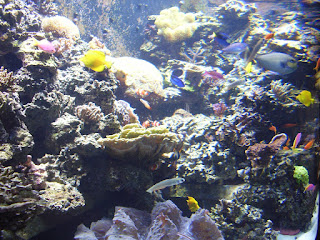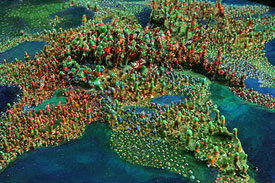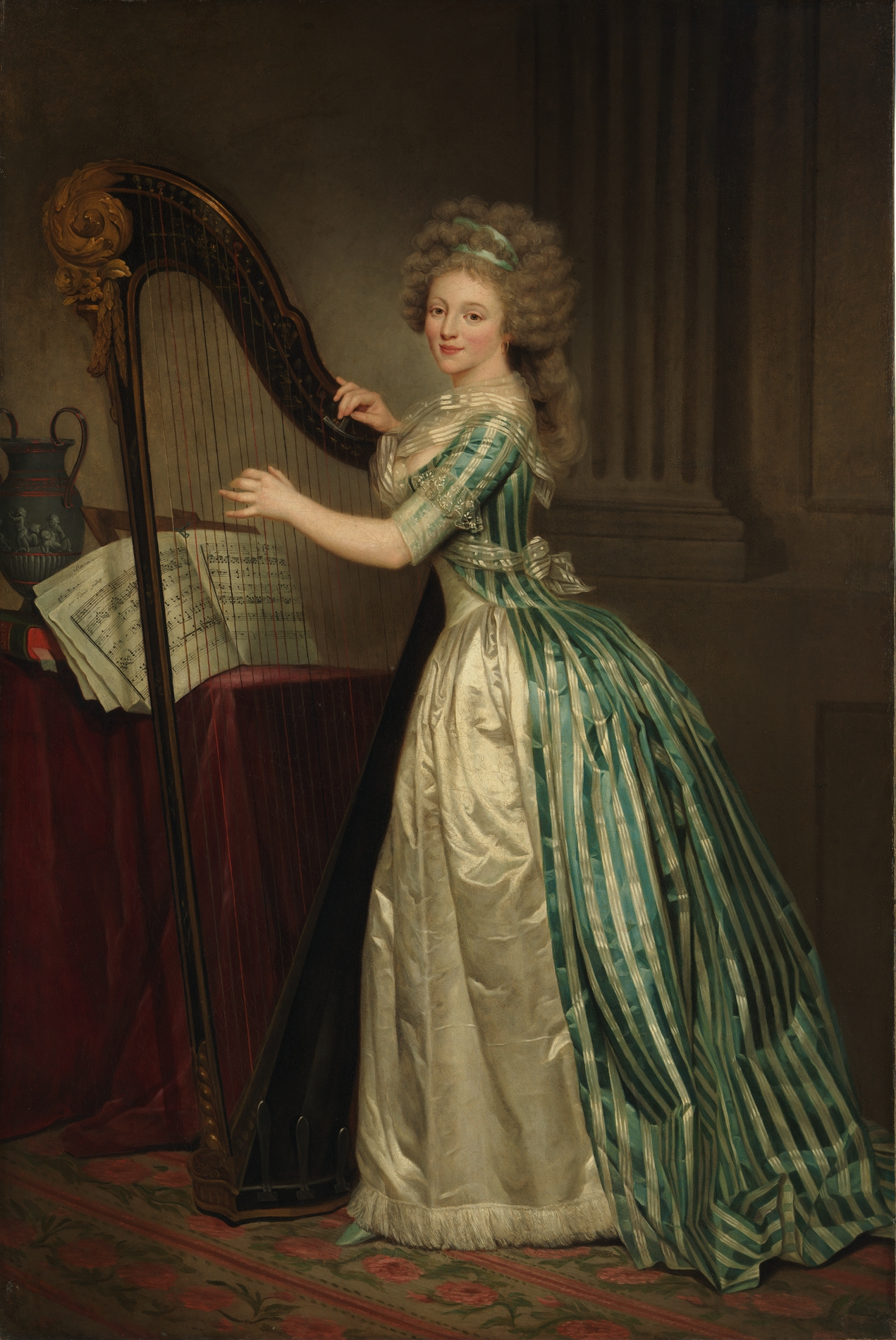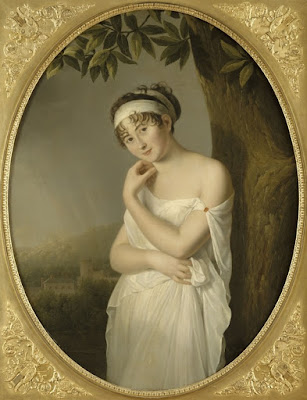by Julie Schauer | Feb 22, 2013 | Art and Science, Encaustic, Environmental Art, Fiber Arts, Folk Art Traditions, Hyperbolic Coral Reef, Painting Techniques, Watercolor
 |
| The Hyperbolic Coral Reef project has spread around the globe |
Nature is mysterious and some of the magical colors and patterns of the coral reef are a wonder of nature’s artistry. Surprisingly, vegetables such as kale, frissée and other lettuces mimic the free-flowing, wild patterns found in the coral reef. These products of nature form hyperbolic planes, not explained by Euclidean Geometry.
Crochet, a fiber art that traditionally has utilitarian purpose, holds the power to make this mystery visible to our eyes. With this in mind, various hyperbolic coral reef projects have sprung up around the globe, bringing together crochet artists to call attention to the fact that this natural wonder — something akin to the oceans’ natural forest — is vastly disappearing as a result of pollution, human waste and climate change.
 |
| Photo of satellite reef, Föhr, Germany, courtesy Uta Lenk |
The Hyperbolic Coral Reef Project is the brainstorm of Margaret and Christine Wertheim, who founded the Institute for Figuring in Los Angeles to highlight this phenomenon. They based their idea on the discovery of a mathematician at Cornell University, Daina Taimina. Taimina used crochet to unlock a mathematical means to explain the parallel nature of crochet lines in 1997, while the Wertheims further developed a repetoire of reef-life forms: loopy “kelps”, fringed “anemones”, crenelated “sea slugs”, and curlicued “corals.” A simple pattern or algorithm, which has a pure shape can be changed slightly to produce variations and permutations of color and form. The Crochet Reef project began in 2005 and the experiment has involved communities of Reefers, which, like the reef itself, have become worldwide. The Wertheim sisters come from Australia, where the Great Barrier Reef is located, while Taimina is originally from Latvia.
 |
| Photo of Actual Coral Reef, from www.thenowpass.com |
These handmade, collaborative works of fiber art have brought together art, science and math to a worldwide community — for the purpose of the sharing a wonder of nature that could be lost. The replica of a coral reef for the Smithsonian Community Reef was a satellite of the Hyperbolic Crochet Coral Reef Project installed at the Smithsonian National Museum of Natural History in 2010-2011. This project has moved and is on view in the Putnam Museum of History and Natural Science in Davenport, Iowa, where it will remain for 5 years. A former student, Jennifer Lindsay supervised the installation and the public outreach at the Smithsonian and the Putman and is currently coordinating the Artisphere Yarn Bomb in Arlington, Va.
 |
| Postcard from the coral reef project in Föhr, Germany |
This past summer, there was an installation at the Museum Kunst der Westkuste on island of Föhr, in Germany. Over 700 artists from the island, and the mainland of Germany and Denmark came together and contributed to the largest of over 20 worldwide projects around the world. At this moment, there is a satellite of the Hyperbolic Crochet Coral Reef Project at Roanoke College in Salem, Va. It will remain there at the Olin Gallery until March 1, 2013, reminding students at this Liberal Arts College of the fragility of the coral reef.
Artist Elise Richman — who lives on the Puget Sound and teaches at the University of the Puget Sound in Tacoma, Wa — also reminds us that changes are afloat at sea. Richman has different processes of painting, each of which reflect environmental systems and states of flux. In the water-based paintings, she applies inks, acrylics and a liquified powder pigment that has been mixed with powder gum arabic. She pours pools of these paints onto thick sheets of watercolor paper, allowing them to expand, evaporate, be absorbed or intermingle, while using minimum control.
 |
| Elise Richman, Each Form Overflows its Present, mixed media on canvas, 2013, photo by Richard Nicol |
The poured paint dries into forms that evoke the contours of islands, water bodies, and/or fluid dynamics. Richman then takes these contours as boundaries that she can transgress in subsequent layers. “I assert my will by deepening the color, adjusting the quality of particular edges and unifying the compositions while maintaining the dynamic sense of flux that the materials activate,” she explains.
More recently, she has used this technique on large-scale canvases. Her newest water-based paintings, such as Each Form Overflows its Present, I, represent an active state of flux as well as topographical formations. They comment, through implication, on the threat of accelerated changes humans have induced on the environment.
 |
| Elise Richman, Isle I, oil, 12 x 12, 2008 photo by Richard Nicol |
Richman also has a body of three-dimensional oil paintings made of organic dots which seem to grown from the canvases. As one moves around the small, intricately-detailed paintings, the topographies and colors change in visually dynamic ways, maintaining their aesthetic beauty. These forms represent non-hierarchical environments. “They evoke tide-pools of miniature islands; intimate marine scapes act as
 |
| Elise Richman, detail of Pool I, 2010, photo by Richard Nicol |
meditations on the processes of painting, an embodiment of time’s passage, and models of the material world’s interconnectedness,” Richman explained. Each mark, point or dot has its own integrity, yet each is subsumed into a larger whole that has an ethical as well as aesthetic dimension. In short, imbalances of power create exploitations of the natural world and groups of people. Yet this largeness of nature can be maintained in works of art that are personal and meditative. Richman’s website includes works in the encaustic and acrylic paint media. The encaustics have multiple layers, from which she scrapes to represent geological formations.
Copyright Julie Schauer 2010-2016
by Julie Schauer | Mar 8, 2012 | 18th Century Art, 19th Century Art, Elizabeth Vigée-LeBrun, Encaustic, Exhibition Reviews, Joseph Vernet, Madame Récamier, National Museum of Women in the Arts, Portraiture, Women Artists
National Museum for Women in the Arts in Washington, DC, is hosting a ground-breaking exhibition, From Royalists to Romantics: Woman artists from the Louvre, Versailles and other French National Collections. The exhibition celebrates the 25th anniversary of NMWA and will continue to be on view until July 29, 2012. It features 35 woman artists who worked between 1750 and 1850.
The women who worked as artists in France at this time went through difficult times of the Revolution and its aftermath, the governments of Napoleon and Napoleon III and uncertainties in
between. They reveal themselves as extraordinary talents, able to overcome so many odds. Many of those who painted and were the subject of portraits reveal themselves as the Renaissance woman of their days. The cover of the catalogue has an alluring portrait of Madame Juliette Récamier, by Eulalie Morin.
Madame Récamier, by Eulalie Morin, late 18th century, is on the cover of the NMWA ground-breaking exhibition. Morin’s Mme Récamier wears a grecian dress and standing in front of an olive tree. Morin used an encaustic technique
Madame Récamier was an extraordinary woman known for holding salons in Paris, hosting notable literary and political figures. She was brilliant, beautiful, charming, witty and politically involved. In time, she was critical of Napoleon, and Madame Récamier went in exile to Italy, but returned to France later. Morin’s portrait dates to the last quarter of the 18th century, before the more famous portraits of Madame Récamier by Jacques-Louis David and Francois Gérard. Morin captured the personality of this charming and clever figure and set her in front of a distant landscape. Her skin is soft and smooth, and the flesh tones contrast nicely with the bright white headband and grecian dress. She stands in front of an olive tree, another tribute to Greece and her interest in the ideals of the classical world. The composition is unified with curves of the face, arm, tree and headband to pull it together and focus on the face. Morin’s Madame Récamier is intimate and alluring. Perhaps as a result of the NMWA exhibition, Morin’s painting will become the iconic image of Madame Recamier, and Eulalie Morin will become better known. (A specific type of couch, a récamier, takes its name from David’s portrait of her.) It’s interesting that Morin primarily painted miniatures, the tiny portraits which went out of vogue with the advent of photography.
Neoclassical style and the simplicity  of white, grecian dress represented sympathy for Republican ideas. A self-portrait of Rose-Adélaïde Ducreux in NMWA’s exhibition shows her bending over a painting, demonstrating her art. However, she shined not only as a painter, but as a musician and composer. Her style compares well next to the work of Jacques-Louis David, most revered painter of the age, especially when we see the texture and shine of an exquisite dresses she painted.
of white, grecian dress represented sympathy for Republican ideas. A self-portrait of Rose-Adélaïde Ducreux in NMWA’s exhibition shows her bending over a painting, demonstrating her art. However, she shined not only as a painter, but as a musician and composer. Her style compares well next to the work of Jacques-Louis David, most revered painter of the age, especially when we see the texture and shine of an exquisite dresses she painted.
A self-portrait of Rose-Adélaïde Ducreux, left, from the Musée des Beaux Arts in Rouen, demonstrates her painting profession.
The current exhibition only features paintings from French museums, but there is a also a full-length self-portrait by Ducreux in the Metropolitan Museum, where she plays the harp. Ducruex was also a musician and composer; this painting, below, was accepted in the Salon of 1791.

Élisabeth Vigée-LeBrun was a prodigy who opened her own painting studio at age 15, supporting her mother and brother. She soon became a favorite of Queen Marie-Antoinette. Marriage and motherhood did not interfere with her career, and she is known for having painted several portraits of herself in affectionate, loving poses with Julie, her daughter.
Vigée-LeBrun did not support the Revolution and left France, only to gain an international reputation as a portrait painter, particularly amongst the nobility of Austria, Russia and Poland. (A recent blog on her is found here.)
Anne Vallayer-Coster was a marvelous still life painter who was voted into Royal Academy in 1770. A favorite of Marie-Antoinette, she seems to have fallen out of favor after the Revolution. Vallayer-Coster, Vigée-LeBrun and Adélaïde Labille-Guiard, were elected into the exclusive French Academy and achieved fame in their day, but there were many other artists of extraordinary talent whom we now can see and recognize in a new light. Many are portrait painters and some are history painters, the latter considered the highest type of art in its time. A few of them painted genre scenes, still lives or landscapes.
The exhibition’s 77 paintings, prints and sculpture mainly come before the invention of photography and do not show its influence. By 1850 the style of Realism had entered the art scene, but the exhibition does not cover this style in which new, younger artists such as Rosa Bonheur were painting. A Legion d’Honneur recipient, Bonheur completed in 1855 her famous The Horse Fair, now in the Metropolitan Museum of Art.
Before the French Revolution, Elisabeth Vigée-LeBrun painted this lively portrait of Joseph Vernet in 1778, primarily using a rich variety of grayish tones. Joseph Vernet was a well-known marine painter who frequently portrayed shipwrecks and other disasters.
These works are on loan from France until July 29, 2012, after which they will travel to Sweden.
Constance Mayer, The Dream of Happiness, from the Louvre, has a Romantic mood, popular in the early 19th century. The exact date is unknown

Copyright Julie Schauer 2010-2016
by Julie Schauer | Nov 2, 2011 | Contemporary Art, Encaustic, Exhibition Reviews, Local Artists and Community Shows, Painting Techniques
 Georgia Nassikas’s triptych, Stone Wall, is in the very old technique of encaustic..
Georgia Nassikas’s triptych, Stone Wall, is in the very old technique of encaustic..McLean Project for the Arts is currently exhibiting three contemporary artists whose techniques involve layering. I was initially attracted there to look at Georgia Nassikas’ paintings made in an encaustic technique. In this medium, paint pigment mixes with beeswax to create a very thick and rugged texture, as seen in Stone Wall, above. Paint must be kept hot during application and it sets quickly. The technique was introduced in Egypt during the Roman Empire, in portraits of the deceased encased in mummies. Nassikas uses the wax from the hives of bees she keeps, as it is necessary to cover the large areas of the multi-layered canvases she paints. Many diverse, uneven shades of color show through the wax in both abstract and landscape paintings.
Carolyn Case has small intimate paintings of oil which also feature layering of a different kind. Her exhibition is called Accidently, On Purpose, suggesting the the works are spontaneous. However, portions of her paintings seem to be cut out or stenciled with different patterns. Even if we cannot figure out how she gets her multi-layered effect with different colors and patterns appearing in front and behind each other, we can get lost in the intricacies and details of her paintings.


Carolyn Case’s intimate paintings are 12″ x 12″
They are Part Potion, left, and Blue vs Blue, right, featuring multiple layers
Finally, Seth Rosenberg’s paintings do not have the layers and textures of paint that Carolyn Case and Georgia Nassikas give to their oils and encaustics. However, his paintings from the “Cleveland Years: 2005-2009” give the illusion of overlapping of abstract and realistic forms.
 Hard Times represents the muted colors from Seth Rosenberg’s Cleveland years, a change from the colorful style of his Washington years.
Hard Times represents the muted colors from Seth Rosenberg’s Cleveland years, a change from the colorful style of his Washington years.He mastered making compositions which combine several different patterns in single paintings which resemble collages. Colors are minimal, almost monochromatic. This artist lived in Washington, DC, for twenty years, but spent five years in Cleveland until his sudden death in 2009. The Rosenberg exhibition originated at the Cleveland Museum of Contemporary Art. Kudos to a small community art center, McLean Project for the Arts, for bringing in such a good traveling exhibition.
Copyright Julie Schauer 2010-2016
















Recent Comments